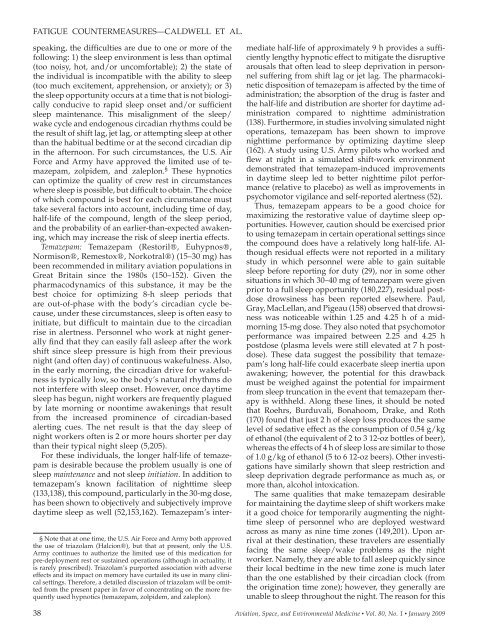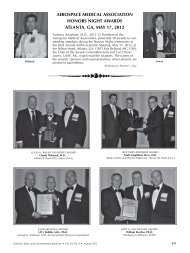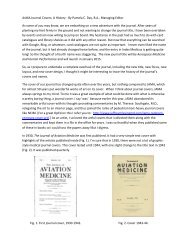Fatigue Countermeasures in Aviation - Aerospace Medical Association
Fatigue Countermeasures in Aviation - Aerospace Medical Association
Fatigue Countermeasures in Aviation - Aerospace Medical Association
You also want an ePaper? Increase the reach of your titles
YUMPU automatically turns print PDFs into web optimized ePapers that Google loves.
FATIGUE COUNTERMEASURES — CALDWELL ET AL.<br />
§ Note that at one time, the U.S. Air Force and Army both approved<br />
the use of triazolam (Halcion w ), but that at present, only the U.S.<br />
Army cont<strong>in</strong>ues to authorize the limited use of this medication for<br />
pre-deployment rest or susta<strong>in</strong>ed operations (although <strong>in</strong> actuality, it<br />
is rarely prescribed). Triazolam’s purported association with adverse<br />
effects and its impact on memory have curtailed its use <strong>in</strong> many cl<strong>in</strong>ical<br />
sett<strong>in</strong>gs. Therefore, a detailed discussion of triazolam will be omitted<br />
from the present paper <strong>in</strong> favor of concentrat<strong>in</strong>g on the more frequently<br />
used hypnotics (temazepam, zolpidem, and zaleplon).<br />
speak<strong>in</strong>g, the difficulties are due to one or more of the<br />
follow<strong>in</strong>g: 1) the sleep environment is less than optimal<br />
(too noisy, hot, and/or uncomfortable); 2) the state of<br />
the <strong>in</strong>dividual is <strong>in</strong>compatible with the ability to sleep<br />
(too much excitement, apprehension, or anxiety); or 3)<br />
the sleep opportunity occurs at a time that is not biologically<br />
conducive to rapid sleep onset and/or sufficient<br />
sleep ma<strong>in</strong>tenance. This misalignment of the sleep/<br />
wake cycle and endogenous circadian rhythms could be<br />
the result of shift lag, jet lag, or attempt<strong>in</strong>g sleep at other<br />
than the habitual bedtime or at the second circadian dip<br />
<strong>in</strong> the afternoon. For such circumstances, the U.S. Air<br />
Force and Army have approved the limited use of temazepam,<br />
zolpidem, and zaleplon. § These hypnotics<br />
can optimize the quality of crew rest <strong>in</strong> circumstances<br />
where sleep is possible, but difficult to obta<strong>in</strong>. The choice<br />
of which compound is best for each circumstance must<br />
take several factors <strong>in</strong>to account, <strong>in</strong>clud<strong>in</strong>g time of day,<br />
half-life of the compound, length of the sleep period,<br />
and the probability of an earlier-than-expected awaken<strong>in</strong>g,<br />
which may <strong>in</strong>crease the risk of sleep <strong>in</strong>ertia effects.<br />
Temazepam: Temazepam (Restoril w , Euhypnos w ,<br />
Normison w , Remestox w , Norkotral w ) (15 – 30 mg) has<br />
been recommended <strong>in</strong> military aviation populations <strong>in</strong><br />
Great Brita<strong>in</strong> s<strong>in</strong>ce the 1980s ( 150 – 152 ). Given the<br />
pharmacodynamics of this substance, it may be the<br />
best choice for optimiz<strong>in</strong>g 8-h sleep periods that<br />
are out-of-phase with the body’s circadian cycle because,<br />
under these circumstances, sleep is often easy to<br />
<strong>in</strong>itiate, but difficult to ma<strong>in</strong>ta<strong>in</strong> due to the circadian<br />
rise <strong>in</strong> alertness. Personnel who work at night generally<br />
f<strong>in</strong>d that they can easily fall asleep after the work<br />
shift s<strong>in</strong>ce sleep pressure is high from their previous<br />
night (and often day) of cont<strong>in</strong>uous wakefulness. Also,<br />
<strong>in</strong> the early morn<strong>in</strong>g, the circadian drive for wakefulness<br />
is typically low, so the body’s natural rhythms do<br />
not <strong>in</strong>terfere with sleep onset. However, once daytime<br />
sleep has begun, night workers are frequently plagued<br />
by late morn<strong>in</strong>g or noontime awaken<strong>in</strong>gs that result<br />
from the <strong>in</strong>creased prom<strong>in</strong>ence of circadian-based<br />
alert<strong>in</strong>g cues. The net result is that the day sleep of<br />
night workers often is 2 or more hours shorter per day<br />
than their typical night sleep ( 5 , 205 ).<br />
For these <strong>in</strong>dividuals, the longer half-life of temazepam<br />
is desirable because the problem usually is one of<br />
sleep ma<strong>in</strong>tenance and not sleep <strong>in</strong>itiation . In addition to<br />
temazepam’s known facilitation of nighttime sleep<br />
( 133 , 138 ), this compound, particularly <strong>in</strong> the 30-mg dose,<br />
has been shown to objectively and subjectively improve<br />
daytime sleep as well ( 52 , 153 , 162 ). Temazepam’s <strong>in</strong>termediate<br />
half-life of approximately 9 h provides a sufficiently<br />
lengthy hypnotic effect to mitigate the disruptive<br />
arousals that often lead to sleep deprivation <strong>in</strong> personnel<br />
suffer<strong>in</strong>g from shift lag or jet lag. The pharmacok<strong>in</strong>etic<br />
disposition of temazepam is affected by the time of<br />
adm<strong>in</strong>istration; the absorption of the drug is faster and<br />
the half-life and distribution are shorter for daytime adm<strong>in</strong>istration<br />
compared to nighttime adm<strong>in</strong>istration<br />
( 138 ). Furthermore, <strong>in</strong> studies <strong>in</strong>volv<strong>in</strong>g simulated night<br />
operations, temazepam has been shown to improve<br />
nighttime performance by optimiz<strong>in</strong>g daytime sleep<br />
( 162 ). A study us<strong>in</strong>g U.S. Army pilots who worked and<br />
flew at night <strong>in</strong> a simulated shift-work environment<br />
demonstrated that temazepam-<strong>in</strong>duced improvements<br />
<strong>in</strong> daytime sleep led to better nighttime pilot performance<br />
(relative to placebo) as well as improvements <strong>in</strong><br />
psychomotor vigilance and self-reported alertness ( 52 ).<br />
Thus, temazepam appears to be a good choice for<br />
maximiz<strong>in</strong>g the restorative value of daytime sleep opportunities.<br />
However, caution should be exercised prior<br />
to us<strong>in</strong>g temazepam <strong>in</strong> certa<strong>in</strong> operational sett<strong>in</strong>gs s<strong>in</strong>ce<br />
the compound does have a relatively long half-life. Although<br />
residual effects were not reported <strong>in</strong> a military<br />
study <strong>in</strong> which personnel were able to ga<strong>in</strong> suitable<br />
sleep before report<strong>in</strong>g for duty ( 29 ), nor <strong>in</strong> some other<br />
situations <strong>in</strong> which 30 – 40 mg of temazepam were given<br />
prior to a full sleep opportunity ( 180 , 227 ), residual postdose<br />
drows<strong>in</strong>ess has been reported elsewhere. Paul,<br />
Gray, MacLellan, and Pigeau ( 158 ) observed that drows<strong>in</strong>ess<br />
was noticeable with<strong>in</strong> 1.25 and 4.25 h of a midmorn<strong>in</strong>g<br />
15-mg dose. They also noted that psychomotor<br />
performance was impaired between 2.25 and 4.25 h<br />
postdose (plasma levels were still elevated at 7 h postdose).<br />
These data suggest the possibility that temazepam’s<br />
long half-life could exacerbate sleep <strong>in</strong>ertia upon<br />
awaken<strong>in</strong>g; however, the potential for this drawback<br />
must be weighed aga<strong>in</strong>st the potential for impairment<br />
from sleep truncation <strong>in</strong> the event that temazepam therapy<br />
is withheld. Along these l<strong>in</strong>es, it should be noted<br />
that Roehrs, Burduvali, Bonahoom, Drake, and Roth<br />
( 170 ) found that just 2 h of sleep loss produces the same<br />
level of sedative effect as the consumption of 0.54 g/kg<br />
of ethanol (the equivalent of 2 to 3 12-oz bottles of beer),<br />
whereas the effects of 4 h of sleep loss are similar to those<br />
of 1.0 g/kg of ethanol (5 to 6 12-oz beers). Other <strong>in</strong>vestigations<br />
have similarly shown that sleep restriction and<br />
sleep deprivation degrade performance as much as, or<br />
more than, alcohol <strong>in</strong>toxication.<br />
The same qualities that make temazepam desirable<br />
for ma<strong>in</strong>ta<strong>in</strong><strong>in</strong>g the daytime sleep of shift workers make<br />
it a good choice for temporarily augment<strong>in</strong>g the nighttime<br />
sleep of personnel who are deployed westward<br />
across as many as n<strong>in</strong>e time zones ( 149 , 201 ). Upon arrival<br />
at their dest<strong>in</strong>ation, these travelers are essentially<br />
fac<strong>in</strong>g the same sleep/wake problems as the night<br />
worker. Namely, they are able to fall asleep quickly s<strong>in</strong>ce<br />
their local bedtime <strong>in</strong> the new time zone is much later<br />
than the one established by their circadian clock (from<br />
the orig<strong>in</strong>ation time zone); however, they generally are<br />
unable to sleep throughout the night. The reason for this<br />
38 <strong>Aviation</strong>, Space, and Environmental Medic<strong>in</strong>e x Vol. 80, No. 1 x January 2009





